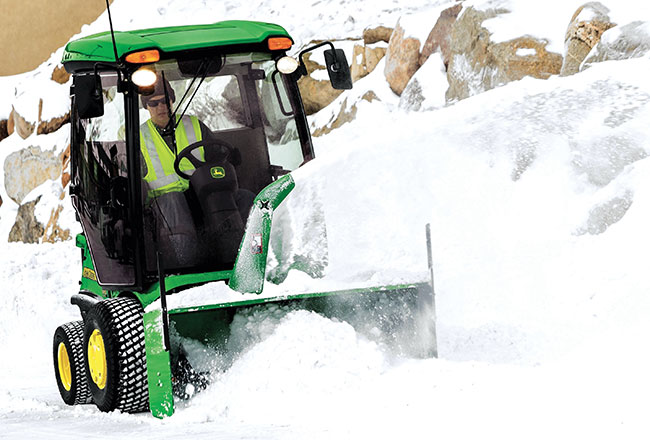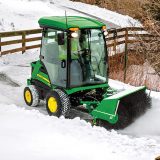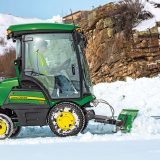
Features
Fall/Winter Preparations
Golf & Landscaping
Ice & Snow Equipment
Mowers
Fall maintenance, winter readiness: tips for landscape operations as fall moves to winter
Proper fall storage of landscaping equipment and getting snow and ice equipment ready
October 20, 2021 By Nick Minas
 A front mower is also ideal for winter work, including plowing and blowing.
Photo Courtesy of John Deere
A front mower is also ideal for winter work, including plowing and blowing.
Photo Courtesy of John Deere As temperatures start to drop – signaling the end of summer and the start of fall – most professional landscape operations may be slowing down while others are preparing for the mowing off-season. This downtime is perfect for getting your equipment and employees ready for the arrival of fall and winter.
As professionals shift from lawn maintenance to other jobs, such as fall cleanup and snow removal, it is critical to take the right steps to set the business up for success come spring. John Deere has five must-do tasks to help landscape contractors maximize their winter downtime.
While you have, hopefully, been cleaning on a regular basis throughout the work season, take a little time to give your equipment a good wash prior to putting it away for the winter. After months and months of mowing, your equipment has accumulated a good bit of dirt and debris, which can be damaging if left untouched for a long period of time.
By washing your machine, you will be able to prevent rust and corrosion. Additionally, a clean machine will make it easier when you go and give your machine a tune-up. On a clean machine, you’ll easily see if any parts are missing, like loose bolts. Also, as you are cleaning, look for any chips or scratches and repair as necessary. Come spring, your machines will be spotless and ready to go.
As we move into the fall and winter seasons, this provides a great opportunity to revamp your equipment, whether through routine maintenance, or major repairs that will lead to machine downtime. It is important to refer to the owner’s manual to ensure that you are completing the necessary maintenance to keep your machine up and running.
Routine maintenance, like an oil change, is good to perform at this time, ensuring that your machine will be ready to go once spring arrives. Also, give tires a once-over. Winter weather can affect tire pressure, particularly if machines have been stored for months. Check the tire pressure and examine treads for wear.
The mower deck and blade are the most important parts of your mower. During the fall and winter season, take the opportunity to inspect and replace any excessively worn belts, or make repairs to the deck shell. A busy mowing season can take a toll on a mower deck and blade, so it is a good idea to pay extra attention to those parts in the off-season.
Check blades for dullness and corrosion. If the blade is dull, sharpen it to ensure a quality cut. Replace any blades that have logged too many hours. It is also important to check blade balance for an even cut.
Wash before storing
As mentioned above, you should wash your equipment, especially prior to storing it for an extended period, by using pressurized air where possible. However, if water is necessary, a low pressure and low flow water is recommended to protect electronics. Make sure to lubricate and cover grease fittings, per your owner’s manual. You want use manufacturer-recommended lubricants, as they were designed to perform to the manufacturer’s specification.
Additionally, be sure to add fuel stabilizers. A fuel stabilizer prevents separation that can lead to corrosion. Simply run the engine for five minutes to ensure the stabilizer is distributed throughout the fuel system. It is always a best practice to change the oil right before storage or before your first start up. Also check coolant if your equipment is liquid cooled. Finally, remove the battery, clean up its terminals, and charge it in the off-season.
Proper service is key to keep the machine running smoothly. While you may believe that you will remember the work you performed in December, by the time March arrives, you probably will have forgotten. Track maintenance in a logbook, which will give you something to refer to in the spring.
The off-season is the perfect time to examine your fleet, as well as your business, and evaluate what you may need for the next season. The first step is to audit your equipment and note any aged equipment that may need to be replaced. Connect with your dealer, who can help not only determine what equipment you need, but also guide you through the purchasing process. If you do need to purchase equipment, meet with your dealer to prepare a quote, and consider all payment options, including upfront cash, financing offers, and leasing offers.
Parts management is vital to limiting machine downtime. Take some time this off-season to revamp your parts department, which will improve your profitability once the mowing season starts up again. First, assign inventory ownership, limiting the number of employees with access to parts storage. With one person overseeing the parts department, it ensures efficient management of the inventory.
Stay organized
Organize and label bin locations, creating a designated, labeled part storage location so that the manager is aware of where things are and what needs restocking. Include a minimum stocking level on the label so the manager knows when things need to be reordered.
Finally, create an immediate tracking process and schedule regular inventory reviews. It may be tempting to wait until the end of the day to track parts that were used, but that increases the chances that a part will be used without notice. Establish an immediate tracking mechanism to limit the risk of forgetting a part through work orders or spreadsheets. Then, on a periodic basis, review the parts inventory, using the time to examine what is being used and adjust minimum levels accordingly.
Add or remove parts that are needed or not needed anymore. If new machines join the fleet, professional landscape contractors need to make sure that they have the right parts. As fleets grow, so does the need for parts. By revamping your business now, you can avoid unnecessary setbacks come spring.
Prepping for cooler weather starts with selecting the right equipment. There are so many options in the market, and choosing the right machine for the application can often feel overwhelming. Fortunately, an equipment dealer is a great resource to help identify the right machine for the job. A dealer will be able to walk through the options, discussing property size and type, the type of jobs you would like to complete, as well as any other special needs, including horsepower.
Equipment for winter needs
There are three primary machines that are used to maintain land during the winter: utility vehicles, front mowers, and compact utility tractors. While all three machines have benefits and features that make each ideal for winter maintenance, each machine can also be used for jobs in warmer months as well.
Utility vehicles can be a great solution for maintenance during the winter months due to the versatility of the machine. From transporting handheld equipment, materials, such as salt, and crew members, to using attachments to prep the grounds before a winter storm, utility vehicles are great for winter maintenance. The ability to customize utility vehicles with a heated cab is ideal for winter, as it keeps workers comfortable and productive, even in below freezing temperatures.
Additionally, utility vehicles are designed to be compatible with a wide variety of attachments. For example, blade attachments can make snow plowing more manageable, while bed sprayers can also double as a de-icing mechanism.
A machine often associated with warm weather jobs is the front mower. While the name may be deceiving, front mowers are ideal for winter work, including snow blowing and plowing. Implements such as snow blowers can attach to front mowers and clear even the most difficult-to-remove snow.
Those located in areas with less snowfall should consider using a rotary broom or blade to remove lighter amounts of snow much more efficiently. Most front mowers have a cab option which further enhances the appeal for users during the cold months.
Another machine that groundskeepers should consider for winter work is a compact utility tractor. Commonly associated with mowing and digging, compact utility tractors can handle a wide variety of tasks through the use of implements.
In winter months, blades, blowers, snow pushers, and brooms help keep grounds clear during the heaviest of snow. Also available with a heated cab, compact utility tractors allow operators to stay productive in all conditions. Additionally, the ability to use other implements, including mowers, loaders, and backhoes, make compact utility tractors a great solution for maintenance throughout the year.
With fall here and winter fast approaching, it’s imperative to make sure equipment is properly prepared for the frigid temperatures. Always maximize the use of attachments and implements, make sure equipment is properly serviced and in good standing, and properly store machines if equipment won’t be used during the winter months.
Nick Minas is go-to-market manager at John Deere.
This article is part of the Fall & Winter Prep Week Week.
Print this page

